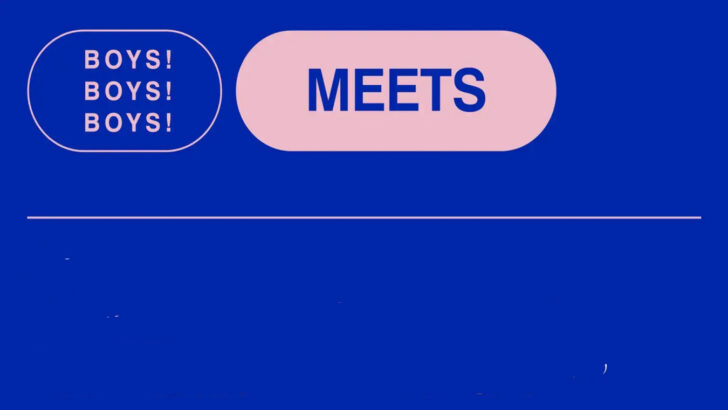In Bodies That Matter, Judith Butler emphasises that gender theory must return to the most material dimension—the body itself. This continues her concept of “performativity” introduced in Gender Trouble, revealing how gender norms are constructed through repeated citation and discipline. The body is not merely a vessel for gender, but a site continually remade under the influence of power and discourse.
In contemporary interdisciplinary art practices, artist Scarlett Wang responds to the theoretical lineage of “performativity” through radical, provocative bodily expressions. She integrates performance art, moving images, and sensorial ritualistic actions to engage not only with gender expression and queer identity but broader themes of human existence, life, and death—an expanded field of “body politics”. Here, the body is understood as a dynamic political vessel—a mechanism of resistance.
Currently based in London, Scarlett Wang has performed at various venues, including Crypt Gallery, Hoxton Cabin, St John’s Church, and Elysium Gallery, delivering site-specific performances during exhibition openings. Using the body as medium, she incorporates Chinese martial arts, shamanic rituals, and East Asian aesthetics and heritage into her queer artistic identity, constructing a sensorial “queer mythology” narrative. The personal is political: confronting racial and gendered marginalisation, Wang treats the body as a site of protest and voice—interrogating how bodies are watched, disciplined, and politicised. Her work deeply explores identity representation and self-construction, embodying collective unconscious and marginalised cultural experiences.
Metaphorical Myth and Bodily Reconstitution
In Keratin, a video work awarded “Best Student Film” at ASVOFF 17, Wang constructs a spiritual-womb visual mythos using symbolic materials—hair, wood, milk, skin, and water. The film portrays a metaphorical myth about the spirit within the uterus, composed of two primordial mothers and a recently separated “child”, who ultimately merge into a chimaera-like being from Greek mythology.
Using visual collage and bodily choreography, the film suggests an amniotic synthesis of sensation and fluidity, representing hormonal and spiritual cycles within a uterine psychic space. This challenges the biological and sociological foundations of gender and identity, echoing poststructuralist theories of the ever-shifting, reconstructed boundary between self and other.
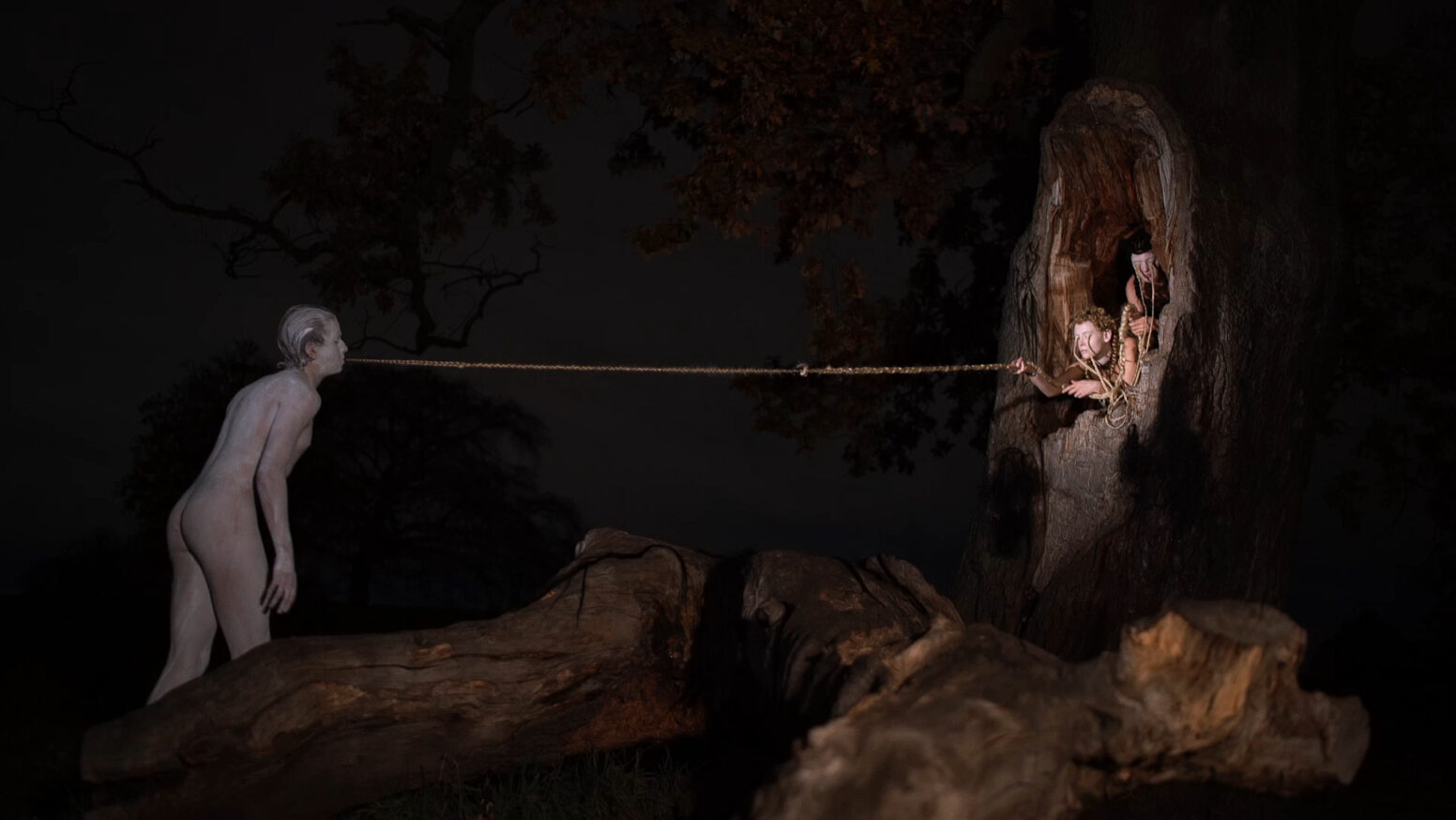
At Hoxton Cabin’s ABINTRA 8 UNDERWORLDS, Wang presentedViscera, a visceral live performance. The performer wore real animal organs strapped to their body using cling film—flesh as clothing, organs as language. Onstage, the body is caught—human and meat. Each extracted organ is honoured with a short poem before being cut apart: lungs, heart, liver, intestines, uterus—each torn off, laid bare before the audience. These organs, usually silent and labouring within, are now exposed in sacrificial rituals. The performance invites audiences to peel away illusions of the human form: obsessions with beauty and denial of mortality. Humanity is, after all, just a shell—a pile of flesh. Like the Daoist concept in Tao Te Ching that “all things are but straw dogs”, this quiet ritual is a protest against the sublime and the shame of the body.
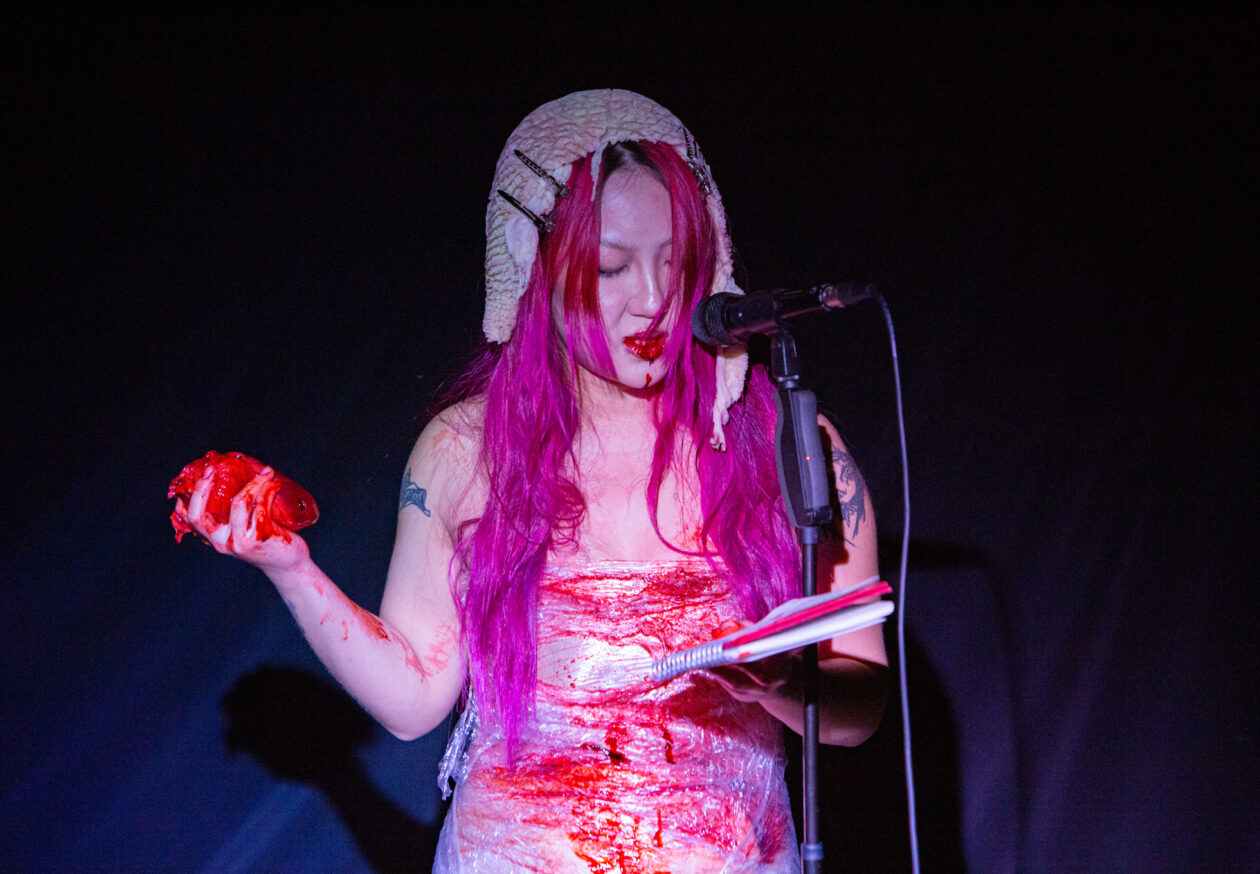
During the immersive art event PORTAL 002 at The Plant Room in London, Wang staged a bodily performance, The Nine-Coloured Deer, merging Buddhist and Celtic mythology. In Celtic lore, the deer represents nature’s mystical forces—sacred yet fragile, divine yet easily betrayed. Wang embodies this nine-coloured deer as a summoning entity with blurred boundaries. Within a surreal forest-like set, she performs a ritual of holiness and violence. Through visual dislocation and sonic interventions, the performance calls viewers to reawaken their senses and reconsider desire, faith, and bodily thresholds. The deer’s body becomes a portal—a sacrificial organism probing the line between instinct and belief, collapsing binaries between subject and other, animal and human.
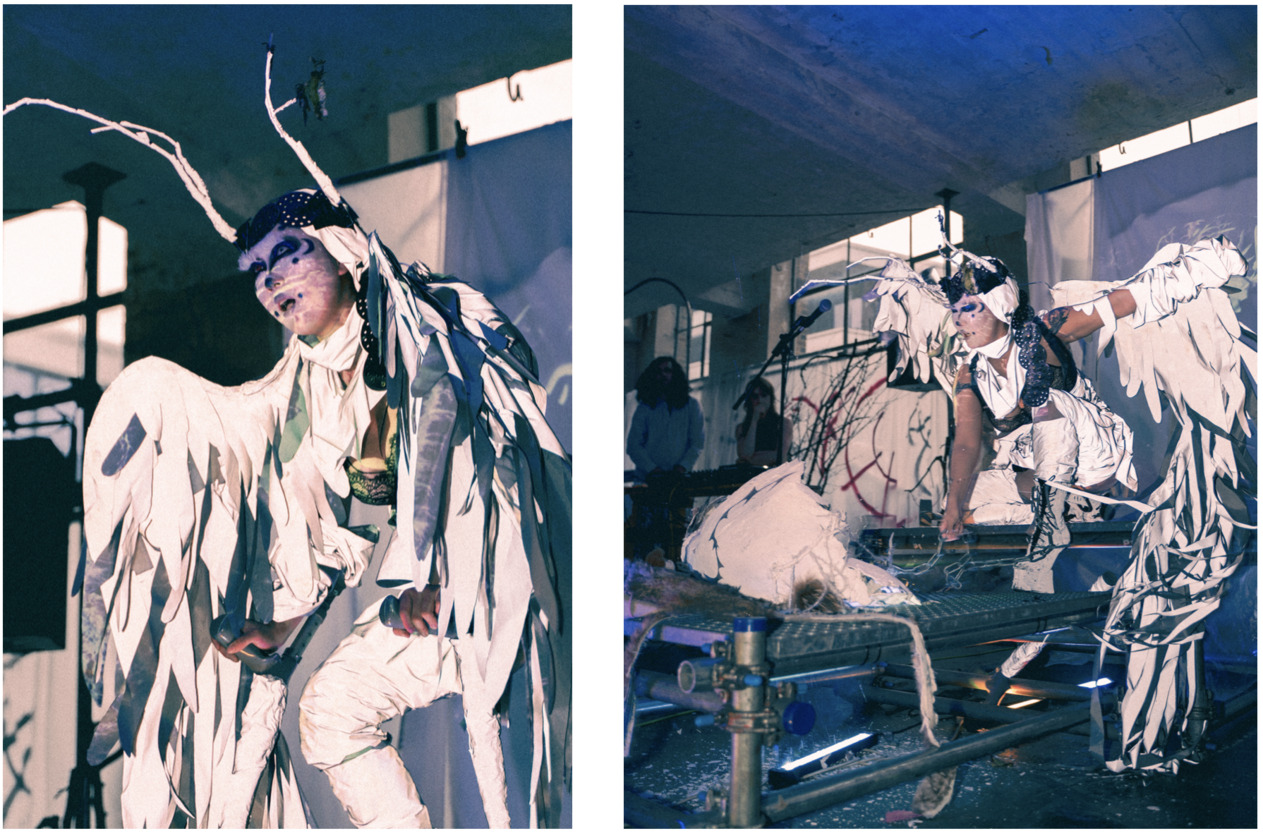
Self and the Collective Unconscious
As the mythic body gains form, the individual emotional experience begins to resonate with the deeper collective unconscious.
In In Search of Some Phantoms, a group exhibition, Wang performed her solo piece Bodhisattva Melt. Inspired by Nuo opera and the iconography of Guanyin (Avalokiteśvara), Wang explores the transformation of Guanyin in East Asian aesthetics—from male to female to a transgender deity—as a cultural metaphor for queer fluidity. This historical evolution of Guanyin reflects gender transition and underscores queer identity’s essence as ever-shifting and unformed. Through this sacred yet erotic multivalent figure, the artist disrupts clear lines between religion and gender, evoking a post-religious, queer spiritual aesthetic embedded in the collective subconscious.

Her video poem Pisces stems from emotional projection, inspired by Lovecraftian nihilism and cultic worship. It’s an exploration of boundaries between spirit and flesh. The work intertwines two obsessions: eroticism intertwined with destructive desire and ritualistic Chinese folk symbols—Nuo masks, trance dances, Five Elements—fluidly reconstructing the relationship between body and spirituality. Filmed with a former lover, the performance shows the partner surrendering to a ritual for a cephalopod deity while Wang plays the divine emissary, leading and “terminating” the sacrifice with trance and shamanic movements. This dynamic reveals the symbolic power structure within their relationship—an intimacy laced with love and destruction, framed by sacred gazes, judgement, and transformation. As a heretical love letter, Pisces uses myth as bone and ritual as tongue, questioning devotion and rebirth. Its nonlinear, visceral poetics whisper of connection, separation, and identity.
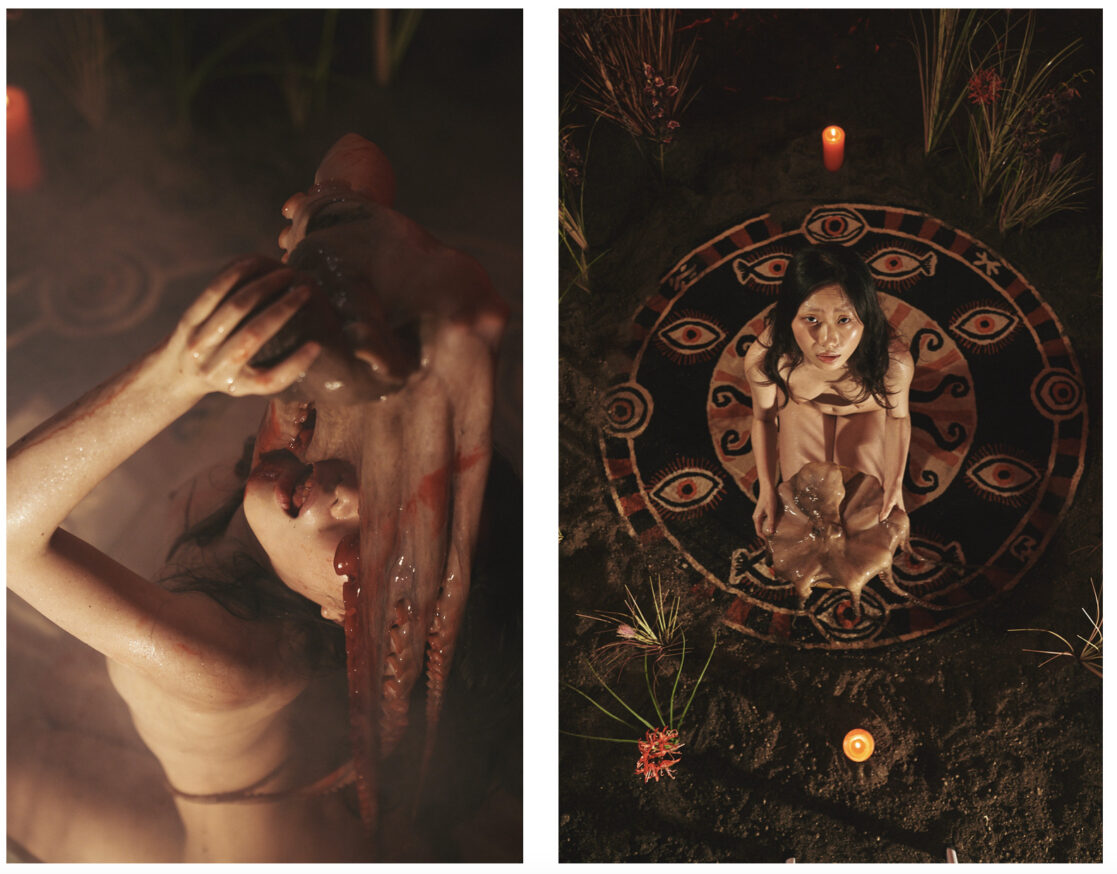
Building a Cross-Cultural Queer Community
Confronting the marginalisation of East Asian queer artists, Wang seeks to bring her work into broader queer communities. In early 2025, she co-organised and performed in Wake Up, a large-scale queer and trans art night in London. A political act across media, it drew nearly 400 attendees and gathered avant-garde artists from Europe and Asia. The event wove performance art, fashion, sound, and video into a historic church. In this space, Wang’s “queer ritual” extended beyond solo expression—it became a transnational, transethnic communal invocation.
Through immersive, ritualised performance, Wang establishes a dialogue between ancestral spiritual traditions and contemporary queer communities. She raises a central question: “Can the body be a temporary home for queer lived experience?” In a globally redefined queer identity, Wang attempts to summon a more sovereign form of bodily existence.
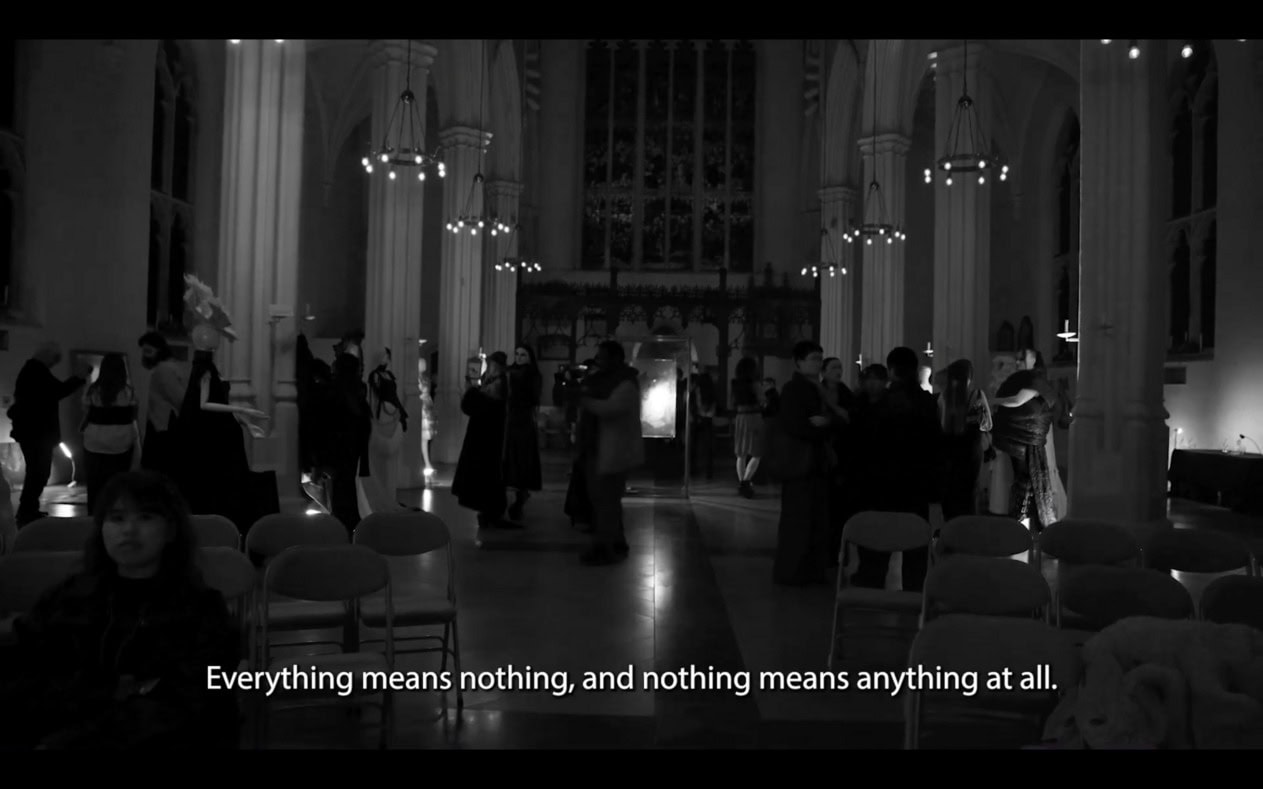
Conclusion
Scarlett Wang’s visual aesthetic is steeped in the grotesque. By displacing the senses and blurring fantasy and reality, she disrupts the mind-body dualism. Her practice reclaims the body as a battlefield of sensation, illusion, and identity. In her works, the body is sculpture, suffering, and invocation. In a context where queer experimental art remains marginalised, Wang’s metaphorical myths and rituals are not merely performances—but political possibilities.
About the Artist:
Scarlett Wang is a Beijing-born, London-based artist, director, and performer. A graduate of Central Saint Martins, her work spans film, performance, installation, and curatorial practice. She explores the intersections of body, myth, spirituality, and gender through hyper-sensorial ritual aesthetics. Drawing on Chinese shamanic traditions, religious symbolism, bodily perception, and queer perspectives, she creates poetic, ritualistic visual spaces. Wang founded the art label WAKE UP and is active across London’s experimental platforms, including Riposte, Torture Garden, PHAROS, and IBA. Her film Keratin has screened internationally and won the “Best Student Film” award at ASVOFF 17.
About the Author:
Freya Fan (Rui Fan, 言蕤) is an arts writer and critic with a background in cultural criticism and curating from Central Saint Martins. Her articles have appeared in Wallpaper, ART021, Anaya Post, Art-Ba-Ba, Ccism, and more. A nominee for the 7th International Awards for Art Criticism (IAAC7), she focuses on feminism, gender awareness, and cultural identity, striving to build bridges between media and narrative.
All images supplied.















